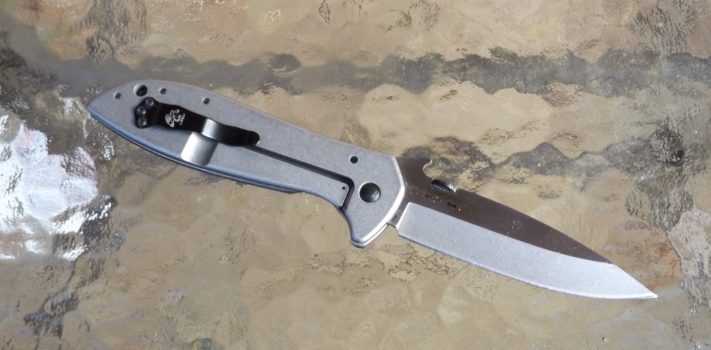Right off the bat, I’ll admit that I’m a huge fan of Ernest Emerson knife designs – all of them. Over the years, I’ve done a number of articles on their factory made knives, as well as some of their knives they had made overseas. I’ve also engaged Emerson in a number of conversations by phone. We both have a similar background, especially in the martial arts, and our love for good cutlery.
One article that I wrote about some folding knives that Emerson had made in China, didn’t exactly please Ernest. I pointed out that of the six samples he sent me for testing and articles had a severe flaw – needless to say, that didn’t sit well with Emerson, but I report my findings, good or bad. There was nothing wrong with the knives or designs at all, the problem was, the handle scales were made out of Zytel (a polymer) and the pocket clips were screwed into the Zytel handle scales – using machine screws – and the screws all pulled out in short order and the pocket clip fell off. Shortly after than Emerson Knives stopped having those knives made. I’m sure Emerson’s original design did not call for machine screws to be used – common sense tells you that, a machine screw is going to pull out of a piece of plastic.
Today, we’re looking at the new Kershaw Knives CQC-4KXL-D2. It is brand-new for this year, and it was designed by Ernest Emerson, and he is one of the best tactical knife designers around – very talented. The “problem” with Emerson Knives, is getting one – they are always in demand – he stopped making custom knives some years ago, and opened a factory to produce his designs. More often than not, whenever I would check his web site, he would be sold out of his many factory knives. So, over the past several years, Emerson collaborated with Kershaw Knives right here in Oregon, to produce some of his designs – keep in mind, most of these knives are a little bit different than those on his web site, but they are still 100% top-notch knives in every respect, and the good news is, they are very inexpensive for the most part. Meaning they are affordable!
Wave Opening Design
Another thing I want to point out is that Emerson’s folders with his patented Wave feature are described as being manual opening. Okay, that’s fair, to a certain extent, but not entirely true, either. Of course, many people actually lust for an automatic opening knife, sorta of…you still have to pull the automatic knife out of your pocket and find the button and push it, to open an “automatic” folder. On Emerson folders that have the Wave feature, it really is very close to automatic opening if you ask me…they are no buttons to push to open the blade, it opens automatically as it is drawn from your pocket. No kidding! Let me explain!
With as little as 5 to 10 minutes of practice, you can easily master the Wave opening feature. When you draw the knife from your pocket, and apply a little bit of pressure towards the back of your pocket, so that the Wave features catches on the top of your pocket, when the knife is fully withdrawn from you pocket, the blade is open and ready to use. That Wave catches on the top of the pocket, with the rearward pressure as you draw the knife and when the knife is fully out of your pocket, it is opened and locked. It is easier to do, than to explain, trust me. So, the Wave feature effectively turns a manually opening folder into an automatic opening folder – if you want it to be that way. You can also use the thumb disk to open the blade. Just don’t apply that rearward pressure on the knife as you draw it from your pocket, and you can use the thumb disk instead – but why open it that way? Check out the video they have on the patented Wave feature and how easy it is to deploy your knife that way…its on the Kershaw and Emerson Knives websites.
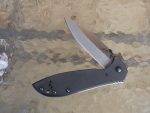 The new CQC-4KXL-D2 is a larger version of another similar folder that Kershaw is producing, and I like bigger folders. I like mine to have a blade between 3.5-inches and 4-inches long, and this one comes in right at 3.9-inches – love it. The blade material is D2 tool steel, and it is a pretty hard steel to work with, but if you get the grind lines just perfect and put a great edge on the D2, then it will hold an edge a good long time. Over the years, I’ve owned a couple of custom-made knives, with the blade made out of D2, and more often than not, the makers just never got a good grind on the edge, and they came with a horrible edge and were next to impossible to sharpen or re-sharpen. However, when the grind on the edge is perfect, the blade holds an edge a very, very long time. And are easy to re-sharpen. Any knives that I carry on a daily basis, are touched-up once a week, and that keeps a keen edge on them – even the D2 blades – they do take a few more strokes to get the blade back to super-sharp, but it works. D2 isn’t a stainless steel, but it doesn’t rust easily.
The new CQC-4KXL-D2 is a larger version of another similar folder that Kershaw is producing, and I like bigger folders. I like mine to have a blade between 3.5-inches and 4-inches long, and this one comes in right at 3.9-inches – love it. The blade material is D2 tool steel, and it is a pretty hard steel to work with, but if you get the grind lines just perfect and put a great edge on the D2, then it will hold an edge a good long time. Over the years, I’ve owned a couple of custom-made knives, with the blade made out of D2, and more often than not, the makers just never got a good grind on the edge, and they came with a horrible edge and were next to impossible to sharpen or re-sharpen. However, when the grind on the edge is perfect, the blade holds an edge a very, very long time. And are easy to re-sharpen. Any knives that I carry on a daily basis, are touched-up once a week, and that keeps a keen edge on them – even the D2 blades – they do take a few more strokes to get the blade back to super-sharp, but it works. D2 isn’t a stainless steel, but it doesn’t rust easily.
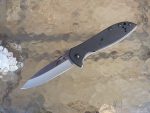 The front handle scale is made out of black G10, and the rear handle is 410 stainless steel – so this knife is built like a tank – very strong…the G10 on the front of the handle covers 410 stainless steel…and it is a liner lock – one of the most popular methods of locking a folder’s blade open, and this sample locks up nice and tight, too – no play at all. The blade finish is tumbled stonewashed for a nice subdued finish, too. The rear handle is bead-blasted for a nice subdued finish as well. When opened, the knife is 9-inches overall, and it weighs-in at 6.1-ounces.
The front handle scale is made out of black G10, and the rear handle is 410 stainless steel – so this knife is built like a tank – very strong…the G10 on the front of the handle covers 410 stainless steel…and it is a liner lock – one of the most popular methods of locking a folder’s blade open, and this sample locks up nice and tight, too – no play at all. The blade finish is tumbled stonewashed for a nice subdued finish, too. The rear handle is bead-blasted for a nice subdued finish as well. When opened, the knife is 9-inches overall, and it weighs-in at 6.1-ounces.
When opening the blade, it is about as smooth as butter, Kershaw simply describes this as having manual washers – whatever they are, they make for a smooth opening – using the Wave or the thumb disk. The pocket clip is reversible, for tip up carry. And Kershaw actually describes the lock as a Frame Lock, and many call it a liner lock – whatever you call it, it is stout! The back spacers are glass filled Nylon, and the screws holding it all together are steel screws – I’m assuming stainless steel. The blade is only available as a plain version – no serrations.
readying for My Tests
When my sample was pulled out of the box, I thought it could be sharper than it was, about 30-seconds on a pair of crock sticks had it where I wanted it to be. There was nothing “wrong” with the sharpness of the blade, but I wanted it a little sharper for my testing, it would have passed all my tests as-is, though.
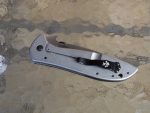 I’ve actually been carrying this folder for a month now – that’s how much I love it. During my testing, it passed every test I could put it through, and regular readers will know that blackberry vines are one of the toughest things you can cut with any knife – and we have wild blackberries all over Oregon, and especially on my small homestead. We love blackberries for all sorts of backing, and just plain eating them off the vine, so we don’t spray them, to kill them…instead, they give me plenty of vines to cut down or in half, and I always test my knives I write about on these wicked vines. The Emerson folder easily cut right through these thick vines with a single swipe of the blade. We also tested cutting up cardboard boxes – one of the more difficult materials you can cut – cardboard dulls a knife like you wouldn’t believe. Then we had poly rope and this material will let a knife blade slip right off of it, if the blade isn’t sharp. Cotton rope was no problem for the Emerson, either.
I’ve actually been carrying this folder for a month now – that’s how much I love it. During my testing, it passed every test I could put it through, and regular readers will know that blackberry vines are one of the toughest things you can cut with any knife – and we have wild blackberries all over Oregon, and especially on my small homestead. We love blackberries for all sorts of backing, and just plain eating them off the vine, so we don’t spray them, to kill them…instead, they give me plenty of vines to cut down or in half, and I always test my knives I write about on these wicked vines. The Emerson folder easily cut right through these thick vines with a single swipe of the blade. We also tested cutting up cardboard boxes – one of the more difficult materials you can cut – cardboard dulls a knife like you wouldn’t believe. Then we had poly rope and this material will let a knife blade slip right off of it, if the blade isn’t sharp. Cotton rope was no problem for the Emerson, either.
The guys at the local gun shop that I haunt love checking out new knives I have on-hand for testing, and they all loved this Emerson folder, and needless to say, the Wave feature method of opening the blade. No negative comments from any of them on this knife sample – very unusual for them to not have anything bad to say.
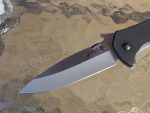 I like to save the best for last, and that is the retail-price on the products I test. Full-retail is only $89.99 on this one, and if it were double that, it would be well worth it…I plan on getting another one, just to have around. Why? I’m notorious for losing knives – and when they get lost in my large front yard, they are lost. Shop around on the ‘net, and I’m sure you’ll find this model for less than the retail-price…if not, the retail-price is still one heck of a bargain for an Emerson-designed folder, and Kershaw did a great job on this one.
I like to save the best for last, and that is the retail-price on the products I test. Full-retail is only $89.99 on this one, and if it were double that, it would be well worth it…I plan on getting another one, just to have around. Why? I’m notorious for losing knives – and when they get lost in my large front yard, they are lost. Shop around on the ‘net, and I’m sure you’ll find this model for less than the retail-price…if not, the retail-price is still one heck of a bargain for an Emerson-designed folder, and Kershaw did a great job on this one.

